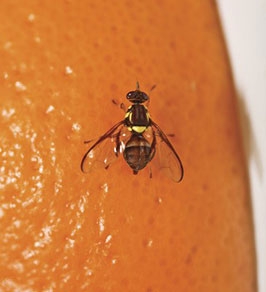|
CDFA has recorded a second detection of Bactrocera tryoni Queensland Fruit Fly (QFF) in Ventura County. This tiny but troublesome pest was found in a residential neighborhood of Thousand Oaks. CDFA considers this a major threat as it is a pest to numerous crops grown in Ventura, including citrus, avocado, peppers, tomatoes, and strawberries. |
|
To address this issue, a quarantine has been placed within a 4.5 mile radius around the detection site and will restrict the movement of all host crops out of the designated boundary until no flies are found within 3 full life cycles. Producers of crops are allowed to move their crops outside of the quarantine area but must apply multiple treatments to their crop prior to harvest. For growers with questions, contact admin@farmbureauvc.com. If you are a resident living within the quarantine zone, it's advisable not to share any homegrown fruit from your yard with friends and neighbors outside of your residence. |
|
The first sighting of the Queensland Fruit Fly in California dates back to 1985 when it was first identified in San Diego. This pest has earned a notorious reputation for wreaking havoc on fruit production in its native Australian habitat, causing an estimated annual damage cost of $28.5 million to crops. While we can't be certain that this fly will establish itself as a major nuisance in our region, the importance of preventing its spread cannot be understated. |
|
QFF has shown an ability to adapt to various environmental conditions and temperatures, making it a potential menace to our citrus crops. Once fruit fly populations take root, they become notoriously challenging to manage. |
|
The Queensland Fruit Fly has an interesting life cycle. It's active during the day but has a peculiar preference for nighttime rendezvous when it comes to mating. Adult female flies lay multiple eggs inside a punctured fruit, which then hatch into larvae after a 2-4 day incubation period. These hungry larvae devour the fruit's flesh with sharp jaws, leading to premature decay and fruit drop. The larvae then enter the soil, pupate, and emerge from the soil as adults. Astonishingly, adult female Queensland Fruit Flies can live for many months, and in some cases, even surpass a year! While the larvae have a taste for fruit, the adult flies have an unconventional preference for leaf surface bacteria, using them as their primary source of protein. |
|
The arrival of the Queensland Fruit Fly in Ventura County may seem like a tiny issue, but its potential impact on our local crops is quite significant. |
